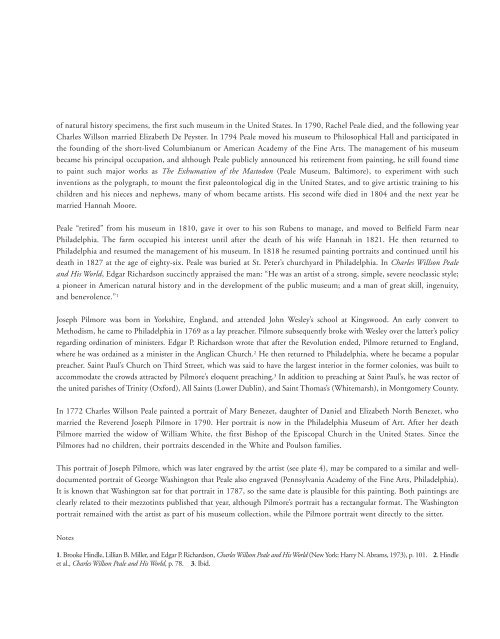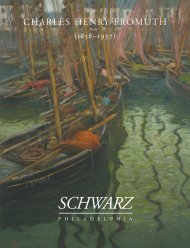pdf - Schwarz Gallery
pdf - Schwarz Gallery
pdf - Schwarz Gallery
You also want an ePaper? Increase the reach of your titles
YUMPU automatically turns print PDFs into web optimized ePapers that Google loves.
of natural history specimens, the first such museum in the United States. In 1790, Rachel Peale died, and the following year<br />
Charles Willson married Elizabeth De Peyster. In 1794 Peale moved his museum to Philosophical Hall and participated in<br />
the founding of the short-lived Columbianum or American Academy of the Fine Arts. The management of his museum<br />
became his principal occupation, and although Peale publicly announced his retirement from painting, he still found time<br />
to paint such major works as The Exhumation of the Mastodon (Peale Museum, Baltimore), to experiment with such<br />
inventions as the polygraph, to mount the first paleontological dig in the United States, and to give artistic training to his<br />
children and his nieces and nephews, many of whom became artists. His second wife died in 1804 and the next year he<br />
married Hannah Moore.<br />
Peale “retired” from his museum in 1810, gave it over to his son Rubens to manage, and moved to Belfield Farm near<br />
Philadelphia. The farm occupied his interest until after the death of his wife Hannah in 1821. He then returned to<br />
Philadelphia and resumed the management of his museum. In 1818 he resumed painting portraits and continued until his<br />
death in 1827 at the age of eighty-six. Peale was buried at St. Peter’s churchyard in Philadelphia. In Charles Willson Peale<br />
and His World, Edgar Richardson succinctly appraised the man: “He was an artist of a strong, simple, severe neoclassic style;<br />
a pioneer in American natural history and in the development of the public museum; and a man of great skill, ingenuity,<br />
and benevolence.” 1<br />
Joseph Pilmore was born in Yorkshire, England, and attended John Wesley’s school at Kingswood. An early convert to<br />
Methodism, he came to Philadelphia in 1769 as a lay preacher. Pilmore subsequently broke with Wesley over the latter’s policy<br />
regarding ordination of ministers. Edgar P. Richardson wrote that after the Revolution ended, Pilmore returned to England,<br />
where he was ordained as a minister in the Anglican Church. 2 He then returned to Philadelphia, where he became a popular<br />
preacher. Saint Paul’s Church on Third Street, which was said to have the largest interior in the former colonies, was built to<br />
accommodate the crowds attracted by Pilmore’s eloquent preaching. 3 In addition to preaching at Saint Paul’s, he was rector of<br />
the united parishes of Trinity (Oxford), All Saints (Lower Dublin), and Saint Thomas’s (Whitemarsh), in Montgomery County.<br />
In 1772 Charles Willson Peale painted a portrait of Mary Benezet, daughter of Daniel and Elizabeth North Benezet, who<br />
married the Reverend Joseph Pilmore in 1790. Her portrait is now in the Philadelphia Museum of Art. After her death<br />
Pilmore married the widow of William White, the first Bishop of the Episcopal Church in the United States. Since the<br />
Pilmores had no children, their portraits descended in the White and Poulson families.<br />
This portrait of Joseph Pilmore, which was later engraved by the artist (see plate 4), may be compared to a similar and welldocumented<br />
portrait of George Washington that Peale also engraved (Pennsylvania Academy of the Fine Arts, Philadelphia).<br />
It is known that Washington sat for that portrait in 1787, so the same date is plausible for this painting. Both paintings are<br />
clearly related to their mezzotints published that year, although Pilmore’s portrait has a rectangular format. The Washington<br />
portrait remained with the artist as part of his museum collection, while the Pilmore portrait went directly to the sitter.<br />
Notes<br />
1. Brooke Hindle, Lillian B. Miller, and Edgar P. Richardson, Charles Willson Peale and His World (New York: Harry N. Abrams, 1973), p. 101. 2. Hindle<br />
et al., Charles Willson Peale and His World, p. 78. 3. Ibid.



